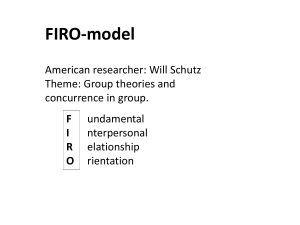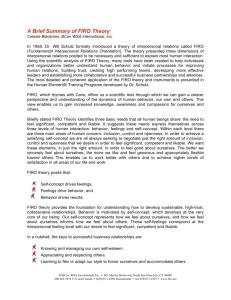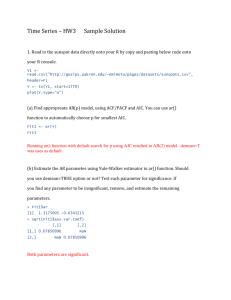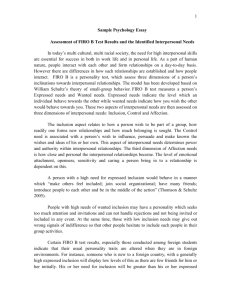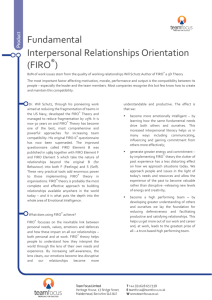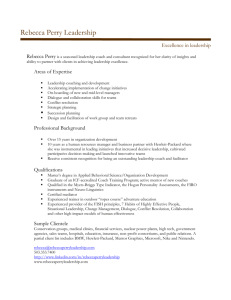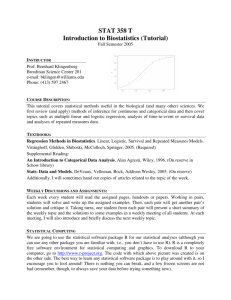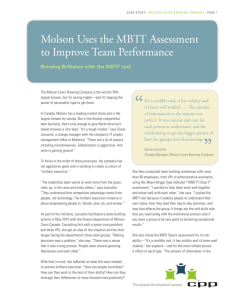Using the FIRO Business
advertisement
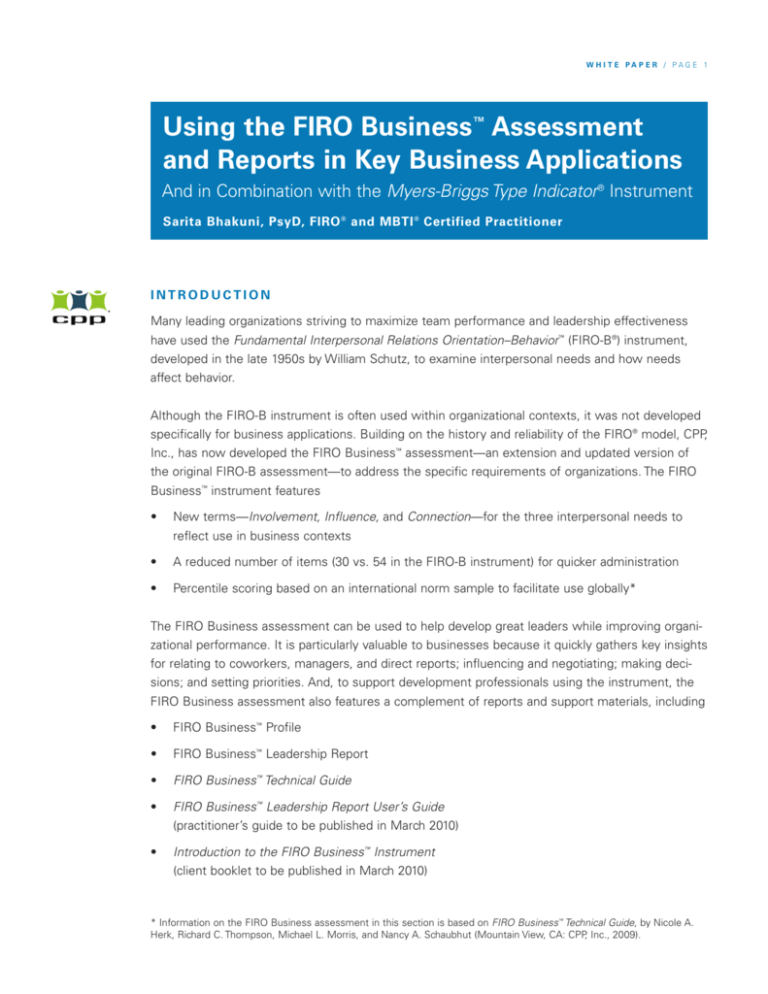
W H I T E PA P E R / PAG E 1 Using the FIRO Business™ Assessment and Reports in Key Business Applications And in Combination with the Myers-Briggs Type Indicator® Instrument Sarita Bhakuni, PsyD, FIRO ® and MBTI ® Certified Practitioner INTRODUCTION Many leading organizations striving to maximize team performance and leadership effectiveness have used the Fundamental Interpersonal Relations Orientation–Behavior™ (FIRO-B®) instrument, developed in the late 1950s by William Schutz, to examine interpersonal needs and how needs affect behavior. Although the FIRO-B instrument is often used within organizational contexts, it was not developed specifically for business applications. Building on the history and reliability of the FIRO® model, CPP, Inc., has now developed the FIRO Business™ assessment—an extension and updated version of the original FIRO-B assessment—to address the specific requirements of organizations. The FIRO Business™ instrument features • New terms—Involvement, Influence, and Connection—for the three interpersonal needs to reflect use in business contexts • A reduced number of items (30 vs. 54 in the FIRO-B instrument) for quicker administration • Percentile scoring based on an international norm sample to facilitate use globally* The FIRO Business assessment can be used to help develop great leaders while improving organizational performance. It is particularly valuable to businesses because it quickly gathers key insights for relating to coworkers, managers, and direct reports; influencing and negotiating; making decisions; and setting priorities. And, to support development professionals using the instrument, the FIRO Business assessment also features a complement of reports and support materials, including • FIRO Business™ Profile • FIRO Business™ Leadership Report • FIRO Business™ Technical Guide • FIRO Business™ Leadership Report User’s Guide (practitioner’s guide to be published in March 2010) • Introduction to the FIRO Business™ Instrument (client booklet to be published in March 2010) * Information on the FIRO Business assessment in this section is based on FIRO Business™ Technical Guide, by Nicole A. Herk, Richard C. Thompson, Michael L. Morris, and Nancy A. Schaubhut (Mountain View, CA: CPP, Inc., 2009). W H I T E PA P E R / PAG E 2 This suite of products makes the FIRO Business assessment ideal for use in key business applications, including leadership development, executive coaching, team building, and conflict management initiatives. Additionally, the FIRO Business assessment can be used in combination with the Myers-Briggs Type Indicator® (MBTI®) instrument, the most widely used personality assessment in the world. This white paper provides practitioners, learning and development professionals, and coaches with information on how to use the FIRO Business assessment and reports in these business applications and as a complement to insights gained from the MBTI assessment. CHOOSING BETWEEN THE FIRO-B® AND FIRO BUSINESS™ INSTRUMENTS Organizations considering the use of an assessment based on the FIRO model can select either the FIRO-B or the FIRO Business assessment using the following criteria. FIRO-B selection criteria: • Organizations already using the FIRO-B assessment and its companion reports and experiencing positive results should continue using the FIRO-B assessment. • Organizations already using the FIRO-B and MBTI assessments in combination for leadership development (including use of the Leadership Report Using the FIRO-B® and MBTI® Instruments) should continue using the FIRO-B assessment. • Professional coaches using the FIRO-B assessment with clients for individual or relationship counseling should continue using the FIRO-B assessment. FIRO Business selection criteria: • Organizations that have used the FIRO-B assessment but require a tool specifically designed for use in business settings, with language that reflects the world of business and that is quicker to administer, should consider using the FIRO Business assessment. • Multinational organizations and those organizations with a multicultural workforce should consider using the FIRO Business assessment—with scoring based on an international norm sample, this tool is ideal for use with a global workforce. • Professional coaches who work with individual clients for development specific to the work environment or business context should consider using the FIRO Business assessment. Both the FIRO-B and FIRO Business assessments provide clients with valuable insights into interpersonal needs that drive behavior. Using the selection criteria above will help ensure optimal results for the end user. W H I T E PA P E R / PAG E 3 A P P L I C AT I O N S F O R L E A D E R S H I P D E V E L O P M E N T We know that the concept of leadership is context dependent and situational. If we examine what drives leadership-related behaviors, we can trace it to needs and the satisfaction of those needs. Opportunities for work excellence flourish when leaders’ interpersonal needs are satisfied. However, when those needs are unmet, challenges arise that can thwart their ability to lead effectively and to optimize the performance of the people and organizations they lead. The FIRO Business assessment and the FIRO Business™ Leadership Report help leaders and potential leaders understand their behavior and provide an excellent foundation for moving development forward. Leaders’ level of self-awareness provides the platform from which they make decisions, yet their performance depends largely on their ability and willingness to connect with others. At its core, leadership involves how individuals interact with their direct reports, peers, and managers. F I R O B u s i n e s s ™ a n d M B T I ® I n s t ru m e n t s — H ow T h ey C o m p l e m e n t E a ch O t h e r The MBTI instrument allows individuals to examine who they are at their core by identifying four preferences indicating how they tend to direct their energy, take in information, make decisions, and deal with the external world. It explores how consistently they use those preferences and also provides information on both inter- and intrapersonal dynamics. The FIRO Business instrument gives individuals a lens through which to view their interpersonal behavior more closely. It measures their interpersonal needs for involvement, influence, and connection and provides information about how those needs impact their behaviors and relationships at work. Because it targets specific, measurable interpersonal behaviors, the FIRO Business instrument is an appropriate tool for coaches and other professionals to use in an individual’s leadership development. P rov i d i n g I n d i v i d u a l a n d G ro u p Fe e d b a ck fo r L e a d e r s h i p D e ve l o p m e n t U s i n g t h e F I R O B u s i n e s s ™ A s s e s s m e n t Results on the FIRO Business assessment provide answers to questions regarding many leadership applications. The FIRO Business™ Leadership Report is a narrative report providing a wealth of practical information that can be used to work through individual and group feedback sessions focused on relating to coworkers, managers, and direct reports; handling negotiation and conflict; and making decisions and setting priorities. Presented are leadership development insights regarding an individual’s strengths, preferences, challenges, and developmental stretches. The FIRO Business™ Profile can be used in combination with the Leadership Report in instances where the presentation of FIRO Business normative or comparison data is helpful. S u g ge s te d E xe rc i s e s fo r C o a ch e s to U s e w i t h T h e i r C l i e n t 1. Ask your client to write down five qualities she appreciates or respects about her mentor or other person in a leadership or management role. Then look at her FIRO Business percentile scores and interpretive categories (high, medium, or low; also known as categorical scores) W H I T E PA P E R / PAG E 4 and talk about whether or not her behaviors interact with and affect her ability to demonstrate these qualities to others. For example, if your client feels her mentor or leader is generous in giving positive feedback to others and she has a low percentile score on Expressed Connection, ask her why she chose to behave differently when she felt good about this behavior directed toward herself. Get your client to provide specific examples and then write down three things she will try to begin doing differently based on emulating her mentor or leader. 2. Look at your client’s results and have a conversation about what she perceives to be the level of effectiveness of her behavior. Ask for two things she could start, stop, or continue in terms of her need for involvement, inclusion, and connection to improve her interpersonal style with others. 3. Ask your client to look at her percentile scores and interpretive categories from the FIRO Business™ Profile and hypothesize how her level of effectiveness might be raised if she were to alter behaviors related to her wanted needs. What if she were to accept help from others on projects instead of going it alone? What if she were to collaborate with others as opposed to completing work in isolation? What if she were to accept opportunities for more informal networking in the office (e.g., eating with others in the lunchroom)? How could this potentially change the way others viewed her or the overall level of her visibility? A P P L I C AT I O N S F O R E X E C U T I V E C O A C H I N G The FIRO Business tool is derived from the FIRO-B model, which has often been used in development work around emotional intelligence, or EQ. As individuals rise within an organization, EQ becomes an essential element of managing others and working with and through others. Often we see executives who display significant technical proficiency in their field lack the ability to connect with and relate to other people. This is where a coach can come in and partner with them to help increase their self-awareness and level of effectiveness. The FIRO Business assessment adds valuable information to the conversation between coaches and clients because it can uncover possible behaviors that can cause executives to get in their own way on the road to success. Coaches can use their understanding of the needs for involvement, influence, and connection to examine growth and opportunities for developing or enhancing these valuable EQ competencies. One key aspect of the FIRO Business™ Profile is that it indicates what individuals are expressing to others and what they want from them in return. When clients are able to recognize the inconsistencies between what they want, what they are asking for, and what they are putting out for others to perceive, the “lightbulb” inevitably comes on and an opportunity for growth begins. F I R O B u s i n e s s ™ a n d M B T I ® I n s t ru m e n t s — H ow T h ey C o m p l e m e n t E a ch O t h e r Coaches frequently use the FIRO-B and MBTI instruments simultaneously to enhance or improve executives’ communication, problem solving, decision making, project management, and connect- W H I T E PA P E R / PAG E 5 ing with others. The MBTI instrument can help people understand why and how individuals of one type might behave in a given situation differently from individuals of another type. Further understanding of the mental functions—Sensing (S), Intuition (N), Thinking (T), and Feeling (F)—can help them learn how better to express the best parts of themselves. Coaches must also be able to help their clients identify behaviors that need to be improved or altered. Using the FIRO Business assessment, coaches can get their clients to understand what they might need first from others in order to be invested in a relationship. In determining the specific need, coaches can then strategize either on managing the need situationally or on trying to satisfy the need through a mutually satisfying relationship. Here are some examples of useful questions for coaches to ask their clients, based on results from each instrument. From the FIRO Business ™ instrument: • When engaged in relationships with others, are you likely to take the initiative in developing a relationship and direct the course your relationship takes? • How important is it for you to be recognized by others, and how do you feel when you are working for a manager who does not consistently acknowledge your contributions? • How comfortable are you with taking the lead and making decisions for others? Is this something you enjoy, and if so, do you allow space for others to collaborate with you in this process? How might others’ perceptions of you improve if you changed your methods in this arena? • Can you take direction from others when contributing to a team project? Or is it important for you to be in the driver’s seat when it comes to decision making? Has this issue had an impact on people’s willingness to work with you on projects? • How important is it for you to feel liked and appreciated by your teammates? How is your work affected when this is not the case on your team? • When you work on a team where members enjoy time with each other outside work, how comfortable are you with joining in? From the MBTI ® instrument: • How could you use your opposite preference in terms of directing your energy to enhance your communication style with others? If you flexed your preference for either Introversion or Extraversion, would it make a noticeable difference in your work relationships? • What keeps you from sharing your ideas with your team? How could you work on sharing your ideas and inserting your voice with others more regularly? • When learning new information for a project, are you asking the right questions to determine the steps needed for implementation? • Are you stepping back enough to see the big picture when strategizing on projects? W H I T E PA P E R / PAG E 6 • In your decision-making process are you more likely to base your decision on what is fair, or on how people are going to be affected? How does that influence your work? • Do you sometimes favor logic in making decisions rather than on who needs to participate to make the project successful? • Are you comfortable with ambiguity when you begin a project, or do you need an outline with scope and steps to begin your work? • Do your creative process and spontaneity enhance or detract from your ability to complete projects in a timely manner? Providing Individual and Group Feedback for Executive Coaching Using the FIRO Business™ Profile Coaching is typically conducted one-on-one, though at times coaches are brought in to train an entire group to enhance their effectiveness. Here are some of the factors coaches should consider when using the FIRO Business assessment and the FIRO Business™ Profile Report with a client: • On which expressed and wanted needs did the client score highest, or lowest? • Are these scores drastically higher or lower than the other scores, or just a little bit different? • Based on these scores, what might be one of the client’s unsatisfied needs? • Is the client’s Total Expressed Need score high or low? • If the client is someone who needs to interact with people on a regular basis, is that need being satisfied in his role as executive? • If the client is not being recognized for his contributions to a team, is he giving himself a voice and expressing what he wants and needs from others? • If the client is taking on too much, is he afraid of the consequences of setting limits and saying no? • Is the client’s level of collaboration with others high enough that he is getting the visibility he seeks in terms of recognition of his accomplishments? • If the client is having a difficult time moving up in the organization, what are the performance gaps that might be showing up as unsatisfied needs on his profile? Additional resources can be used to help identify some of the client’s opportunities for development as indicated by the scores. Table 35 in the FIRO Business™ Technical Guide summarizes significant correlations between FIRO Business scores and Adjective Check List items. The Adjective Check List, or ACL, uses 300 common adjectives or phrases to describe a person’s characteristics or attributes. When FIRO Business and ACL results are compared, consistencies between descriptions and behaviors can verify or refute hypotheses generated from an interpretation of a FIRO Business™ Profile. This comparison can also provide a hint of what the client may be demonstrating to the outside world as well as managing internally. W H I T E PA P E R / PAG E 7 S u g ge s te d E xe rc i s e s fo r C o a ch e s to U s e w i t h T h e i r C l i e n t 1. Ask your client whether any of the Need scores she received were surprising to her, and why. If she can name a score that surprised her, talk more about how she could more effectively demonstrate her need for this behavior from others or accept it when it is directed toward her. It is possible that she may not even be aware of what she is putting out to others in this area; the insight derived from this conversation could prove to be invaluable in her interpersonal relationships. 2. Take a look at your client’s highest percentile score on either an expressed or wanted need. Ask her to think of one thing she could do differently to satisfy this need through channels other than work. A P P L I C AT I O N S F O R T E A M B U I L D I N G The FIRO-B instrument was created to aid in the formation of productive and effective teams. With the FIRO Business instrument, the FIRO model’s original utility can be expanded by looking at what an individual needs to be a successful team contributor. Most of people’s interactions with others are influenced and informed by whether they think the other person is an ally or is presenting a hurdle. If clients understand work relationships as being transactional, they can use their results from the FIRO Business instrument to examine what they are giving to, as well as what they are receiving from, others. When these elements are in balance, and clients feel that what they are giving is being appropriately recognized and what they are receiving is sufficiently rewarding, then a behavior within that need category (Involvement, Influence, or Connection) is deemed consistent with one that will meet their needs. For team members, part of contributing to the team’s success is understanding both what they bring to the table and what the team needs from them, and balancing those two elements appropriately. When people’s needs are being met on a team, they engage, contribute, collaborate, and produce. When their needs are unsatisfied, they withdraw, complain, procrastinate, and sabotage. If we look at the needs for involvement, influence, and connection across a team, we can begin to understand the story the data tell us about team synergy, gaps, productivity, and relationships. F I R O B u s i n e s s ™ a n d M B T I ® I n s t ru m e n t s — H ow T h ey C o m p l e m e n t E a ch O t h e r From a team-building standpoint, the FIRO-B and MBTI instruments can be used simultaneously to enhance or improve executive communication, problem solving, decision making, project management, and connecting with others. The MBTI instrument provides information about what the individual brings to a team by describing his or her preferences and possible areas of proficiency and expertise as well as possible challenges or shortcomings. Functions pairs can be seen as drivers and motivators in terms of team cohesiveness and communication style. Using results from the FIRO Business instrument, we can drill down even further to predict how individual styles may or W H I T E PA P E R / PAG E 8 may not mesh together on a team, based on people’s interpersonal needs and what the consequences may be if those needs are not satisfied. As a team-building tool, the FIRO Business instrument helps individuals understand the need for complementary alignment of roles and goals across a team and the possible synergies that may result. MBTI insights about type can contribute to the dialogue between team members by providing a common language with which to speak about individual needs and preferences. The FIRO Business instrument can take it a step further by identifying unsatisfied needs and interpersonal tensions and their effect on team performance. An extremely low score on an individual’s profile can help uncover potential frustrations and suggest further exploration. P rov i d i n g I n d i v i d u a l a n d G ro u p Fe e d b a ck fo r Te a m B u i l d i n g Using the FIRO Business™ Assessment The FIRO Business™ Profile contains information about an individual’s needs as they relate to the needs of others and provides insight into professional relationships. In addition, the profile outlines how interested the individual is in establishing relationships with coworkers, which directly affects his or her investment in the team. How individuals express behavior to others depends on a multitude of variables, including the relevance of that behavior to overall satisfaction. It is important to note that what individuals express to others can be affected by conditions other than what they might need—for example, expectations of others, work environment and interpersonal expectations, and response to colleagues’ needs. Following the “Introduction” section of the profile are three sections reporting and interpreting scores: “Your Expressed Needs,” “Your Wanted Needs,” and “Your Total and Overall Scores.” Each section demonstrates how much individuals express each need—Involvement, Influence, and Connection—to their colleagues, and to what extent they accept all three behaviors from others. The “Your Expressed Needs” section provides indications about behaviors individuals are likely to demonstrate or initiate when interacting with other members of the team. Information presented in this section can motivate individuals to ask themselves the following kinds of questions: • How much time and energy am I likely to spend relating to coworkers versus working independently on my own projects? • Am I likely to be seen as a team player, or as an independent contributor? • How do I share information with others on the team? • How much time alone do I need versus time with the team to feel balanced on the job? • Do I share similar information with everyone, or do I pick and choose my confidants? • Am I clear about what I expect from team members and what they expect from me? • Are my behavior and communication style on the team consistent most of the time? W H I T E PA P E R / PAG E 9 • What could I change to be more successful on the team? • How could I stretch myself and learn how to express the best parts of myself to my teammates? The “Your Wanted Needs” section provides indications about behaviors individuals are likely to want others to demonstrate or initiate toward them. When wanted needs are unfulfilled, it may become an opportunity for individuals to contemplate their role in why those needs may not be understood by others. Information presented in this section can motivate individuals to ask themselves the following kinds of questions: • Am I satisfied with my level of involvement on team projects? • Do I have the appropriate information to perform well in my role? • Do teammates share their appreciation of my contribution to overall team performance? • Am I comfortable with how much influence I have on the team? • Do I want a more “hands-on” style from my manager or supervisor? • Do teammates provide encouragement and support during difficult times when I need it? • Do I enjoy getting to know others in the office, or do I prefer more businesslike relationships? The last section of the profile, “Your Total and Overall Scores,” describes the level of interpersonal interaction and involvement individuals need from others to be satisfied. Information presented in this section can motivate individuals to ask themselves the following kinds of questions: • Am I getting enough time alone to finish my work, or am I too often pulled into conversations or meetings that consume my energy? • Do I enjoy collaborating with others on projects, or do I prefer work that requires only my input? • Does the organization provide enough structure to help me understand what I need to do to perform successfully? • Do I understand what needs to be done to make an impact on the team? • Do I feel comfortable when other colleagues seem to share close personal friendships? • Is work another place to go where I enjoy the company of my colleagues? These questions can help individuals begin a dialogue with their team regarding what story the data from the FIRO Business Profile are telling. If the team is performing well and has reached a high level of productivity, answering those questions will be easier than if the team is not working effectively. W H I T E PA P E R / PAG E 10 S u g ge s te d E xe rc i s e fo r C o a ch e s to U s e w i t h T h e i r C l i e n t 1. Ask your client to examine the percentile scores and interpretive categories of members of his team before meeting with them collectively. Are they similar across the board, or different? If they are similar, ask the client what sorts of things tend to cause team members to become irritated with each other to the point that it becomes a distraction. Oftentimes when the majority of people on the team desire the same behavior, that is, score high on the same wanted need (say, Wanted Involvement), that leaves only a few team members to do most of the work to fulfill this need. This is especially pronounced when, of those, only one or two score high on the corresponding expressed need (in this case, Expressed Involvement). In such cases the client should ask his fellow team members for ideas on how to share the load of meeting each other’s needs more equally. On the other hand, if the percentile scores are generally in the low range, he should explore whether this is an unsatisfied need or an area on which the team does not need to pay a great deal of attention. A P P L I C AT I O N S F O R C O N F L I C T M A N A G E M E N T The Harvard Negotiation Project has produced books such as Getting to Yes (Fisher & Fry, 1983) and Difficult Conversations (Stone, Patton, & Heen, 1999) that address the degree to which conflict can be a roadblock in a work environment. An executive can be an intelligent, hardworking team player, but if she lacks the ability to successfully address, manage, and resolve conflict situations, her development will be stalled. We know that conflict is an integral part of our everyday personal and professional lives, yet many people avoid or deny the need to manage it directly. • Individuals can use the FIRO Business model to expand their perception of the way they manage conflict. Most often people enter into a conflict with another person because they do not feel heard, feel frustrated, are in a power struggle, or are not getting what they need from that person. The FIRO Business™ Profile addresses these and other topics in terms of individuals’ needs for involvement, influence, and connection. Here are some examples of questions individuals may want to ask themselves when using the profile results to manage conflict: • Involvement. Are there times when I feel left out of the loop and my feelings are hurt and I feel frustrated? Do I know who needs to be included in projects to cover all my bases? Do I feel defensive at times when I am denied information shared by others in the office? • Influence. Do I ever take the stance of “My way or the highway”? Are people afraid to share their ideas with me for fear of what my reaction will be? Do I state what I am thinking or feeling even if it opposes the general consensus? • Connection. Do I need to feel that others agree with me or enjoy working with me? Is it difficult to collaborate with someone who I know does not enjoy working with me? When I disagree with other people’s ideas, am I reluctant to share this with them at the risk of losing their friendship? The FIRO Business™ Profile provides individuals with an understanding of their approach to managing conflict and the strategies they can use in working through conflict with others. When they W H I T E PA P E R / PA G E 11 think about their results on the profile, they can use them to determine how they might answer the following questions: • How (if at all) do I use empathy and understanding while negotiating with another person? Do I look for commonalities? • How do I exert power when negotiating with others? • How could I stretch myself to be more effective when negotiating with others? • How do I create trust between myself and the opposing party? • Do I take time to show that I understand and care about the other person’s feelings? • Is my approach to negotiating fair, or do I sometimes rush to closure to reach an agreement? • Am I an advocate for my own needs during conflict? F I R O B u s i n e s s ™ a n d M B T I ® I n s t ru m e n t s — H ow T h ey C o m p l e m e n t E a ch O t h e r One of the most common reasons people use the MBTI instrument to deal with conflict situations is that it provides a benign and common language with which to address personal similarities and differences. The FIRO Business instrument examines people’s needs during a conflict—their highest-scoring expressed and wanted needs are likely the needs they pay attention to first during a conflict situation. We can hypothesize that if they have the self-awareness to know from the beginning how to enter into a conflict situation based on keeping themselves calm and approachable, then a favorable outcome is obtainable. Using the FIRO Business and MBTI instruments simultaneously provides a more complete data set from which to understand what is happening during a conflict on an interpersonal level and what this will look like in terms of behavior. When people understand their general approach to relationships, they can better determine what they need in order to be open to resolving a conflict. Based on MBTI type theory, it is understood that the way individuals are likely to respond to conflict is indicated by their function pair (the middle two letters of their four-letter type). Let’s examine how we might hypothesize an approach to conflict based on each function pair by type: • STs (Sensing Thinking types). STs may approach conflict by providing details about what happened and the logic of why the conflict does or doesn’t make sense to them. They believe the conflict should be resolved based on what has been proven and what is right or fair. This approach does not always take into account how people may feel about the conflict. STs provide detailed analysis during a conflict that forces people to be specific about their thoughts and ideas. • NTs (Intuitive Thinking types). NTs tend to be rather competitive in conflict situations. They believe strongly in the importance of being competent; anyone whom they deem to be incompetent will lose credibility in a negotiation or discussion. NTs tend to be blunt and direct and W H I T E PA P E R / PAG E 12 seem to be more concerned about being right than hearing other’s perspectives. NTs try to look at the big picture during a conflict and are eager to get to the bottom line of the situation. • NFs (Intuitive Feeling types). NFs may try to avoid conflict, as it causes them great discomfort when someone is upset or frustrated with them. They often feel they have let the other person down and feel responsible, even when the responsibility does not fall on them. They want everyone to get along and prefer a win-win approach to conflict. NFs are great at trying to get people to be on the same page and collaborate. They can diffuse tension by reminding people that they are on the same team and ultimately need to reach a consensus. • SFs (Sensing Feeling types). SFs often prefer a step-by-step approach to managing a conflict and want the end results to benefit people. They are willing to get involved in the unpleasantness of conflict if it ultimately serves to make things better for others. Though they may not always speak up about how they feel and may get their feelings hurt, they can be tenacious in their commitment to making sure people get what they need. They tend to consider the minutia of what people might need to feel satisfied. An uderstanding of MBTI type can provide insight into individuals’ behavior in conflict. The FIRO Business assessment enhances that insight by providing current information about how they are feeling and what their needs are now. As individuals consider the significance of their function pair in conflict situations, here are some examples of questions they might ask themselves as they reflect on their FIRO Business™ Profile: • Do I need time to myself to think about what I am feeling? • Is this an issue of “winning” or power over the other person? • Am I concerned about the state of my relationships with the other people involved? Are my relationships with the other people involved at risk? • If I take a stand, will someone be disappointed or hurt? • Do I want to take responsibility for making a decision or suggestion? • Do I feel secure enough to volunteer my ideas during the negotiation process? By examining their data on the FIRO Business™ Profile, individuals will be better prepared to answer all of these questions. P rov i d i n g I n d i v i d u a l a n d G ro u p Fe e d b a ck fo r C o n f l i c t M a n a ge m e n t U s i n g t h e F I R O B u s i n e s s ™ A s s e s s m e n t a n d P ro f i l e The best way for individuals to understand their behavior during conflict is to examine the need they tend to satisfy first in a relationship. Here’s how they can use FIRO Business™ Profile results to understand their conflict approach: W H I T E PA P E R / PAG E 13 • For individuals whose highest-scoring need is Involvement. You will want to be in the know about news, projects, and processes. If people neglect to share such information with you, you will tend to find it off-putting and upsetting. In order to feel satisfied with your level of involvement during a conflict, tell the other parties the kind of information you need to know and how much contact you will be expecting from them. Be clear and specific about your intentions to communicate with them as well as the amount and kind of communication you are expecting from them. • For individuals whose highest-scoring need is Influence. Think about the hierarchies that may exist in your relationships with other people involved in the conflict. The way you understand your position of power in relation to them will determine your level of comfort in being diplomatic or agreeable. Keep in mind your end goal and try to listen to the goals of others and what they may need from you. You may be able to get buy-in from others by providing them with what they need first. Though this may feel like “giving in,” it is actually a smart negotiating move. • For individuals whose highest-scoring need is Connection. Think about the importance of your relationships with those people involved in the conflict. If you trust them and have a solid appreciation for how they perceive you, you may feel more comfortable asserting what you need for yourself during a conflict. If you do not share with them what you need or are looking for as a part of the negotiation, remind yourself how you will feel afterward if you do not advocate for yourself. While it may seem noble to be the one to sacrifice for the sake of others, excess sacrifice can leave you feeling frustrated and resentful. S u g ge s te d E xe rc i s e fo r C o a ch e s to U s e w i t h T h e i r C l i e n t s 1. If you are working with a team or other group, have individual members identify their highestscoring need on their FIRO Business™ Profile and then talk about how that might inform or influence their willingness to compromise or arrive at an agreeable solution in a conflict situation. They should also review their lowest-scoring need on the profile and think about how they would approach conflict differently if that were their highest and most important need to satisfy first. How would that change their perspective? How would their approach and behavior change? CONCLUSION The FIRO Business assessment and its companion reports—the FIRO Business™ Profile and the FIRO Business™ Leadership Report—provide valuable information about interpersonal needs for involvement, influence, and connection. Individuals can use the information presented to examine their overall needs and how these impact the way they behave with others for the key business applications discussed above—leadership development, executive coaching, team building, and conflict management. They can also use insights gained from the FIRO Business assessment to complement insights gained from the MBTI assessment for a more complete picture of another W H I T E PA P E R / PAG E 14 individual or team. If they can understand more about their relationships and what they want from them, they can position themselves to be more involved in getting their needs met. What the FIRO Business line of products offers individuals is greater self-awareness and insight. Need scores tell, for example, the story of how much involvement they want with others, whether or not they need to have influence over others to feel important, and the extent and level of connection they need in order to feel present and engaged in their work. The FIRO Business™ Profile can help them take steps toward creating more manageable scenarios in which to be successful. Furthermore, it can help them create strategies based on leadership, coaching, team building, or conflict applications that challenge them to pay attention to their needs in the moment—specifically, relating to coworkers, managers, and direct reports; handling negotiation and conflict; making decisions; and setting priorities. This is the “presence” Peter Senge speaks about of executives who have had a wildly successful career—they pay attention to who they are and what they need and are engaged in their everyday interactions at a level that makes all the difference. Sarita Bhakuni, PsyD, is a licensed psychologist, trainer, senior organizational development consultant, and assessment expert based in Chicago, Illinois. With experience in a broad range of industries, including pharmaceutical, health care, financial services, technology, retail, automobile, education, and nonprofit, she specializes in creating growth while managing change for both individuals and organizations. She holds a master’s degree and doctorate in clinical psychology from the Illinois School of Professional Psychology in Chicago, where she is currently a faculty member, and a biomedical bachelor of science degree from Ohio State University. As a consultant for CPP, Inc., Dr. Bhakuni designed and delivered programs in conflict, leadership, diversity empowerment, career development and transition, change and stress management, effective communication, coaching, team building, and mentoring for corporations across the country. She is now an independent consultant and a certified practitioner of the Myers-Briggs Type Indicator® (MBTI®), FIRO®, California Psychological Inventory™ (CPI™), and Strong Interest Inventory® assessments. CPP—The People Development People At CPP, our only job is to help you be a better people development professional and, in turn, help every employee flourish. While we’re best known for our products like the Myers-Briggs® assessment, CPP is also a group of people who can offer you the information, guidance, and support you need. Your guide to performance. We offer solutions to help you improve organizational performance and address whatever challenges you face—from team building, leadership and coaching, and conflict management to career development, selection, and retention. Perhaps that’s why millions of individuals in more than 100 countries use our products each year. They include people at Fortune 500 companies and businesses of all sizes, as well as educators, government agencies, and training and development consultants. Among CPP’s world-renowned brands are the Myers-Briggs Type Indicator® (MBTI®), Strong Interest Inventory®, ThomasKilmann Conflict Mode Instrument (TKI), FIRO®, CPI 260®, and California Psychological Inventory™ (CPI™) assessments. Let’s make a difference together. Talk to us today to see how. 800-624-1765 : www.cpp.com : The Myers-Briggs® experts California Psychological Inventory, CPI, Fundamental Interpersonal Relations Orientation–Behavior, FIRO, FIRO-B, FIRO Business, Strong Interest Inventory, and the CPP logo are trademarks or registered trademarks of CPP, Inc., in the United States and other countries. Myers-Briggs Type Indicator, Myers-Briggs, and MBTI are trademarks or registered trademarks of the MBTI Trust, Inc., in the United States and other countries.
